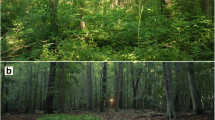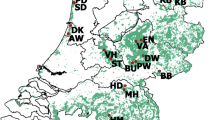Abstract
In the northeastern USA, active forest management can include timber harvests designed to meet silvicultural objectives (i.e., harvesting trees that meet certain maturity, height, age, or quality criteria). Timber harvesting is an important tool in enhancing regeneration and maintaining forest health. It also has considerable potential to influence transmission dynamics of tick-borne pathogens, which are deeply embedded in the forest ecosystem. We conducted a 2-year study to test the hypotheses that recent timber harvesting impacts blacklegged tick density and infection prevalence in managed nonindustrial forests. We found that (1) recent harvesting reduces the presence of nymphal and density of adult blacklegged ticks, (2) recently harvested stands are characterized by understory microclimate conditions that may inhibit tick survival and host-seeking behavior, (3) capture rates of small mammal species frequently parasitized by immature ticks are lower in recently harvested stands compared to control stands with no recent harvest history. In addition, a 1-year pilot study suggests that harvesting does not affect nymphal infection prevalence. Collectively, our results demonstrate that forest structure and understory conditions may impact ticks and the pathogens they transmit via a range of mechanistic pathways, and moreover, active forest management may offer sustainable tools to inhibit entomological risk of exposure to tick-borne pathogens in the landscape.





Similar content being viewed by others
References
Allan BF, Keesing F, Ostfeld RS (2003) Effect of forest fragmentation on Lyme disease risk. Conservation Biology 17:267–272
Allan BF, Dutra HP, Goessling LS, Barnett K, Chase JM, Marquis RJ, Pang G, Storch GA, Thach RE, Orrock JL (2010) Invasive honeysuckle eradication reduces tick-borne disease risk by altering host dynamics. Proceedings of the National Academy of Sciences USA 107:18523–18527
Anderson DB (1936) Relative humidity or vapor pressure deficit. Ecology 17:277–282
Arsnoe I, Hickling G, Ginsberg H, McElreath R, Tsao J (2015) Different populations of blacklegged tick nymphs exhibit differences in questing behavior that have implications for human Lyme disease risk. PLoS One 10(5):e0127450
Bates D, Machler M, Bolker B, Walker S (2015) Fitting linear mixed-effects models using lme4. Journal of Statistical Software 67:1–48
Berger KA, Ginsberg HS, Gonzalez L, Mather TN (2014) Relative humidity and activity patterns of Ixodes scapularis (Acari: Ixodidae). Journal of Medical Entomology 51:769–776
Bertrand MR, Wilson ML (1996) Microclimate-dependent survival of unfed adult Ixodes scapularis (Acari: Ixodidae) in nature: life cycle and study design implications. Journal of Medical Entomology 33:619–627
Boyer N, Réale D, Marmet J, Pisanu B, Chapuis JL (2010) Personality, space use and tick load in an introduced population of Siberian chipmunks Tamias sibiricus. Journal of Animal Ecology 79:538–547
Brooks RT (2003) Abundance, distribution, trends, and ownership patterns of early-successional forests in the northeastern United States. Forest Ecology and Management 185:65–74
Brooks ME, Kristensen K, van Benthem KJ, Magnusson A, Berg CW, Nielsen A, Skaug HJ, Maechler M, Bolker BM (2017) glmmTMB balances speed and flexibility among packages for zero-inflated generalized linear mixed modeling. The R Journal 9:378–400
Brownstein JS, Skelly DK, Holford TR, Fish D (2005) Forest fragmentation predicts local scale heterogeneity of Lyme disease risk. Oecologia 146:469–475
Brunner JL, Ostfeld RS (2008) Multiple causes of variable tick burdens on small-mammal hosts. Ecology 89:2259–2272
Chapman DG (1951) Some properties of hyper-geometric distribution with application to zoological census. University of California Publications Statistics 1:131–160
D’Amato AW, Bradford JB, Fraver S, Palik BJ (2011) Forest management for mitigation and adaptation to climate change: insights from long-term silviculture experiments. Forest Ecology and Management 262:803–816
Daniels TJ, Falco RC, Fish D (2000) Estimating population size and drag sampling efficiency for the blacklegged tick (Acari: Ixodidae). Journal of Medical Entomology 37:357–363
Dunn JM, Davis S, Stacey A, Diuk-Wasser MA (2013) A simple model for the establishment of tick-borne pathogens of Ixodes scapularis: a global sensitivity analysis of R0. Journal of Theoretical Biology 335:213–221
Elias SP, Witham JW, Hunter ML (2004) Peromyscus leucopus abundance and acorn mast: population fluctuation patterns over 20 years. Journal of Mammalogy 85:743–747
Gaff H, Eisen RJ, Eisen L, Nadolny R, Bjork J, Monaghan AJ (2020) LYMESIM 2.0: an updated simulation of blacklegged tick (Acari: Ixodidae) population dynamics and enzootic transmission of Borrelia burgdorferi (Spirochaetales: Spirochaetaceae). Journal of Medical Entomology 57:715–727
Gardner AM, Muturi EJ, Overmier LD, Allan BF (2017) Large-scale removal of invasive honeysuckle decreases mosquito and avian host abundance. EcoHealth 14:750–761
Gasperini S, Mortelliti A, Bartolommei P, Bonacchi A, Manzo E, Cozzolino R (2016) Effects of forest management on density and survival in three forest rodent species. Forest Ecology and Management 382:151–160
Gleim ER, Conner LM, Berghaus RD, Levin ML, Zemtsova GE, Yabsley MJ (2014) The phenology of ticks and the effects of long-term prescribed burning on tick population dynamics in southwestern Georgia and northwestern Florida. PLoS One 9:11
Gleim ER, Zemtsova GE, Berghaus RD, Levin ML, Conner M, Yabsley MJ (2019) Frequent prescribed fires can reduce risk of tick-borne diseases. Scientific Reports 9:1–10
Halsey SJ, Allan BF, Miller JR (2018) The role of Ixodes scapularis, Borrelia burgdorferi and wildlife hosts in Lyme disease prevalence: a quantitative review. Ticks and Tick-Borne Diseases 9:1103–1114
Hinkelman TM, Orrock JL, Loeb SC (2012) Effect of downed woody debris on small mammal anti-predator behavior. Ethology 118:17–23
Hofmeester TR, Jansen PA, Wijnen HJ, Coipan EC, Fonville M, Prins HHT, Sprong H, van Wieren SE (2017a) Cascading effects of predator activity on tick-borne disease risk. Proceedings of the Royal Society b: Biological Sciences 284:20170453
Hofmeester TR, Rowcliffe JM, Jansen PA (2017b) Quantifying the availability of vertebrate hosts to ticks: a camera-trapping approach. Frontiers in Veterinary Science 4:115
Hofmeester TR, Sprong H, Jansen PA, Prins HHT, Sipke E (2017c) Deer presence rather than abundance determines the population density of the sheep tick, Ixodes ricinus, in Dutch forests. Parasites and Vectors 10:433
Hojgaard A, Lukacik G, Piesman J (2014) Detection of Borrelia burgdorferi, Anaplasma phagocytophilum and Babesia microti with two different multiplex PCR assays. Ticks and Tick-Borne Diseases 5:349–351
Jin S, Sader SA (2006) Effects of forest ownership and change on forest harvest rates, types and trends in northern Maine. Forest Ecology and Management 228:177–186
Keirans JE, Litwak TR (1989) Pictorial key to the adults of hard ticks, family Ixodidae (Ixodida: Ixodoidea) east of the Mississippi River. Journal of Medical Entomology 26:435
Levi T, Kilpatrick AM, Mangel M, Wilmers CC (2012) Deer, predators, and the emergence of Lyme disease. Proceedings of the National Academy of Sciences USA 109:42–47
Lindenmayer DB (1994) Timber harvesting impacts on wildlife: implications for ecologically sustainable forest use. Australian Journal of Environmental Management 1:56–68
LoGiudice K, Ostfeld RS, Schmidt KA, Keesing F (2003) The ecology of infectious disease: effects of host diversity and community composition on Lyme disease risk. Proceedings of the National Academy of Sciences USA 100:567–571
Oksanen J, Blanchet FG, Friendly M, Kindt R, Legendre P, McGlinn D, Minchin PR, O’Hara RB, Simpson GL, Solymos P, Stevens M, Szoecs E, Wagner H (2018) vegan: Community ecology package. R package version 2.5-2. Available: https://CRAN.R-project.org/package=vegan. [accessed May 2, 2020]
Orrock JL, Danielson BJ, Brinkerhoff RJ (2004) Rodent foraging is affected by indirect, but not by direct, cues of predation risk. Behavioral Ecology 15:433–437
Ostfeld RS, Levi T, Keesing F, Oggenfuss K, Canham CD (2018) Tick-borne disease risk in a forest food web. Ecology 99:1562–1573
Oswalt SN, Smith WB (2014). U.S. Forest Resource Facts and Historical Trends. Available: https://www.fia.fs.fed.us/library/brochures/docs/2012/ForestFacts_1952-2012_English.pdf. [accessed May 2, 2020]
Padgett KA, Casher LE, Stephens SL, Lane RS (2009) Effect of prescribed fire for tick control in California chaparral. Journal of Medical Entmology 46:1138–1145
Patrick DA, Hunter ML, Calhoun AJ (2006) Effects of experimental forestry treatments on a Maine amphibian community. Forest Ecology and Management 234:323–332
Peranzi C, Robinson S (2020) Report to Maine Legislature: Lyme and other tickborne illnesses. <https://www.maine.gov/dhhs/mecdc/infectious-disease/epi/vector-borne/lyme/documents/Lyme-Legislative-Report-2020.pdf>
Perret JL, Guigoz E, Rais O, Gern L (2000) Influence of saturation deficit and temperature on Ixodes Ricinus tick questing activity in a Lyme borreliosis-endemic area (Switzerland). Parasitology Research 86:554–557
Pukkala T (2016) Which type of forest management provides most ecosystem services? Forest Ecosystems 3:9
Raymond P, Bédard S, Roy V, Larouche C, Tremblay S (2009) The irregular shelterwood system: review, classification, and potential application to forests affected by partial disturbances. Journal of Forestry 107:405–413
Raymond P, Munson AD, Ruel JC, Coates KD (2006) Spatial patterns of soil microclimate, light, regeneration, and growth within silvicultural gaps of mixed tolerant hardwood white pine stands. Canadian Journal of Forest Research 36:639–651
Reid FA (2006) A field guide to mammals of North America north of Mexico. New York: Houghton Mifflin Company
Rogers AJ (1955) The abundance of Ixodes scapularis Say as affected by burning. The Florida Entomologist 38:17–20
Rosenberg R, Lindsey NP, Fischer M, Gregory CJ, Hinckley AF, Mead PS, Maz-Bailey G, Waterman SH, Drexler NA, Kersh GJ, Hooks H (2018) Vital signs: trends in reported vector-borne disease cases – United States and Territories, 2004–2006. Morbidity and Mortality Weekly Report 67:496
Scasta JD (2015) Fire and parasites: an under-recognized form of anthropogenic land use change and mechanism of disease exposure. EcoHealth 12:398–403
Stafford KC (1994) Survival of immature Ixodes scapularis (Acari: Ixodidae) at different relative humidities. Journal of Medical Entomology 31:310–314
Stafford KC, Ward JS, Magnarelli LA (1998) Impact of controlled burns on the abundance of Ixodes scapularis (Acari: Ixodidae). Journal of Medical Entomology 35:510–513
Thompson ID, Baker JA, Ter-Mikaelian M (2003) A review of the long-term effects of post-harvest silviculture on vertebrate wildlife, and predictive models, with an emphasis on boreal forests in Ontario, Canada. Forest Ecology and Management 177:441–469
Tufts DM, McClure M, Diuk-Wasser MA (2020) Ixodes scapularis (Acari: Ixodidae) nymphal survival and host-finding success in the eastern United States. Journal of Medical Entomology. Online ahead of print
Vail SG, Smith G (2002) Vertical movement and posture of blacklegged tick (Acari: Ixodidae) nymphs as a function of temperature and relative humidity in laboratory experiments. Journal of Medical Entomology 39:842–846
Waring KM, O’Hara KL (2005) Silvicultural strategies in forest ecosystems affected by introduced pests. Forest Ecology and Management 209:27–41
Williams SC, Ward JS, Worthley TE, Stafford KC (2009) Managing Japanese barberry (Ranunculales: Berberidaceae) infestations reduces blacklegged tick (Acari: Ixodidae) abundance and infection prevalence with Borrelia burgdorferi (Spirochaetales: Spirochaetaceae). Environmental Entomology 38:977–984
Williams SC, Ward JS (2010) Effects of Japanese barberry (Ranunculales: Berberidaceae) removal and resulting microclimatic changes on Ixodes scapularis (Acari: Ixodidae) abundances in Connecticut, USA. Environmental Entomology 39:1911–1921
Wilson ML (1986) Reduced abundance of adult Ixodes dammini (Acari: Ixodidae) following destruction of vegetation. Journal of Economic Entomology 79:693–696
Witham JW, Moore EH, Hunter ML, Kimball AJ, White AS (1993) A long-term study of an oak pine forest ecosystem: techniques manual for the Holt Research Forest. https://digitalcommons.library.umaine.edu/cgi/viewcontent.cgi?article=1053&context=aes_techbulletin
Xu G, Mather TN, Hollingsworth CS, Rich SM (2016) Passive surveillance of Ixodes scapularis (Say), their biting activity, and associated pathogens in Massachusetts. Vector-Borne and Zoonotic Diseases 16:522–527
Acknowledgements
We thank Grace Cullinane, Troy Cloutier, Alyssa Marini, and Samantha Nigida for their assistance with field data collection, Brandon Lieberthal and Alessio Mortelliti for their assistance with statistical analyses, Anne Lichtenwalner, Ann Bryant and Tom Rounsville for their assistance with tick-borne pathogen detection assays, and members of the Gardner Lab at the University of Maine for their helpful feedback throughout the study. We thank Blue Hill Heritage Trust, Carter Nature Preserve, and three private landowners for land use permission. This study was supported by a USDA National Institute of Food and Agriculture grant (Project No. ME012450318) to AMG and JEL, Hatch funds through the Maine Agricultural and Forest Experiment Station (Project Nos. ME021826 and ME021905) to AMG, and a University of Maine Graduate Student Government grant to CEC.
Author information
Authors and Affiliations
Corresponding author
Rights and permissions
About this article
Cite this article
Conte, C.E., Leahy, J.E. & Gardner, A.M. Active Forest Management Reduces Blacklegged Tick and Tick-Borne Pathogen Exposure Risk. EcoHealth 18, 157–168 (2021). https://doi.org/10.1007/s10393-021-01531-1
Received:
Revised:
Accepted:
Published:
Issue Date:
DOI: https://doi.org/10.1007/s10393-021-01531-1




